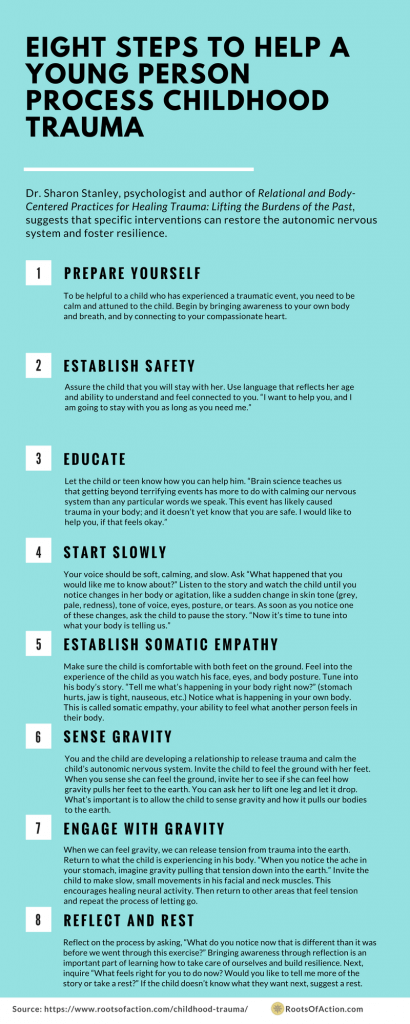
Childhood trauma often occurs from distressing events or relationships that exceed a young person’s ability to understand or process a traumatic experience. Most of us link trauma with tragedies like mass shootings, rape, accidents, war, or natural disasters. But childhood trauma is also associated with “adverse childhood experiences” (ACES) including physical, sexual, or emotional abuse; neglect; violence; or separation, divorce, or incarceration of a household member. Trauma symptoms are triggered by many emotionally challenging incidents, including bullying, with effects that can last a lifetime. Symptoms of childhood trauma may include feelings of anxiety, panic, abandonment, sadness, worthlessness, and other core emotions.
The latest neuroscience research helps us understand that childhood trauma goes beyond language or logic. Trauma lives in children’s bodies, creating harmful patterns in their autonomic nervous systems – a system of the brain more powerful than thoughts and emotions.
There is neuroscientific evidence that all of us, children and adults, have embodied trauma that impacts our lives. But with the right support and relationships, we can learn to regulate the effects of trauma on our brains, strengthening our ability to adapt to the many adversities of modern life. This is part of developing resilience, the ability to meet and overcome challenges in ways that maintain or promote well-being.
An empathetic and safe relationship with a skilled adult can regulate the effects of childhood trauma on the brain. Dr. Sharon Stanley, psychologist and author of Relational and Body-Centered Practices for Healing Trauma: Lifting the Burdens of the Past, suggests that specific interventions can restore the autonomic nervous system and foster resilience.
Eight Steps to Help a Young Person Process Childhood Trauma
Dr. Stanley advises that parents, teachers, counselors, and other helpers can be very effective in helping kids heal from childhood trauma by supporting them following critical incidents that cause anxiety. These might include watching news of a mass shooting, being bullied at school, or seeing a friend be hurt. She provided the following brain-based intervention, grounded in the latest neuroscientific research.
This step-by-step process for calming and restoring the autonomic nervous system can help transform childhood trauma into resilience. It is designed to be used by an empathetic, compassionate adult, working with a child to help them process trauma. To heal from past, unresolved traumas, Dr. Stanley recommends that a child work with a professional in the field of trauma and body-based therapies.
Familiarize and become comfortable with all the steps before you begin working with a child:
1. Prepare yourself.
To be helpful to a child who has experienced a traumatic event, you need to be calm and attuned to the child. Begin by bringing awareness to your own body and breath, and by connecting to your compassionate heart.
2. Establish safety.
Assure the child that you will stay with her. Use language that reflects her age and ability to understand and feel connected to you. “I want to help you, and I am going to stay with you as long as you need me.”
3. Educate.
Let the child or teen know how you can help him. “Brain science teaches us that getting beyond terrifying events has more to do with calming our nervous system than any particular words we speak. This event has likely caused trauma in your body, and it doesn’t yet know that you are safe. I would like to help you if that feels okay.” Explain that you can guide him in some simple exercises that can help him feel safe, calm, and in control again. Tell him that you will be doing these exercises with him and that you will pause to ask how he is doing, and that he can say “stop” at any time.
4. Start slowly.
Your voice should be soft, calming, and slow. Ask “What happened that you would like me to know about?” Listen to the story and watch the child until you notice changes in her body or agitation, like a sudden change in skin tone (grey, pale, redness), tone of voice, eyes, posture, or tears. As soon as you notice one of these changes, ask the child to pause the story. “Now it’s time to tune into what your body is telling us.”
5. Establish somatic empathy.
Make sure the child is comfortable with both feet on the ground. Feel into the experience of the child as you watch his face, eyes, and body posture. Tune into his body’s story. “Tell me what’s happening in your body right now?” (stomach hurts, jaw is tight, nauseous, etc.) Notice what is happening in your own body. This is called somatic empathy, your ability to feel what another person feels in their body.
6. Sense gravity.
You and the child are developing a relationship to release trauma and calm the child’s autonomic nervous system. Invite the child to feel the ground with her feet. When you sense she can feel the ground, invite her to see if she can feel how gravity pulls her feet to the earth. You can ask her to lift one leg and let it drop. What’s important is to allow the child to sense gravity and how it pulls our bodies to the earth. Continue to notice your own body’s sensations.
7. Engage with gravity.
When we can feel gravity, we can release tension from trauma into the earth. Return to what the child is experiencing in his body. “When you notice the ache in your stomach, imagine gravity pulling that tension down into the earth.” Invite the child to make slow, small movements in his facial and neck muscles. This encourages healing neural activity. Then return to other areas that feel tension and repeat the process of letting go. A release of tension may be accompanied by a sigh, deep breath, or movement. As this process evolves, you are watching the child become more calm and restful. You will notice this in his face and posture. What enables the nervous system to recover its natural vitality is twofold: 1) somatic empathy between you and the child, and 2) the physical release of the child’s tension into the earth.
8. Reflect and rest.
Reflect on the process by asking, “What do you notice now that is different than it was before we went through this exercise?” Bringing awareness through reflection is an important part of learning how to take care of ourselves and build resilience. Next, inquire “What feels right for you to do now? Would you like to tell me more of the story or take a rest?” If the child doesn’t know what they want next, suggest a rest. “Would you like me to sit with you while you rest?” If she wants to talk more about the traumatic event, repeat the steps you just went through until she is ready to rest, an integral part of the restorative process.
Childhood trauma is complex, and it often takes a village of people to support a child or teen who suffers from symptoms of trauma. Becoming familiar with Dr. Stanley’s 8-step process and being ready to sit with a child in a moment of need can help build their resilience for a lifetime. These types of brain-based, body-centered interventions are easy to learn and should be part of every adult’s toolkit.
For additional academic references on trauma and the role of the autonomic nervous system, read my related article at Psychology Today, “How to Heal from Unspeakable Terror.” Note that Dr. Stanley’s intervention can be used for children and adults. You may wish to learn about her research with trauma, and her training in Somatic Transformation™.
Infographic to Use and Share
Feel free to use, share, or print this infographic to remind yourself of the ways adults can help young people process childhood trauma and foster healing and resilience.
Published: October 5, 2017




